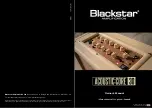
English
10
English
9
Front Panel
Channel 1
1. Input (1/4" instrument jack)
Plug your acoustic instrument in here. Always use a good quality screened
instrument cable.
2. Gain
This controls the input gain of Channel 1. Turning it clockwise increases the input
gain, increasing the volume.
3. Enhance
This switch applies a studio-style EQ and spatial process to your instrument sound.
With this switch in the OUT position the EQ is flat, providing a natural-sounding
starting point for most instruments. The IN position engages an advanced DSP
algorithm which gives a sense of space and depth to your sound.
4. Low
The LOW control adjusts the amount of bass frequencies in your tone.
This amplifier has active tone-shaping which allows the low frequencies to
be precisely controlled for both the desired sound and also to help control
instrument resonances.
5. High
The HIGH control allows exact adjustment of the treble frequencies within your
sound. At low settings (counter-clockwise) the sound will be warm and darker in
character. As the control is increased (clockwise) the sound will become brighter
and more lively.
6. Chorus
This knob controls the two Super Wide Stereo Chorus effects; VINTAGE and WIDE.
Each of these effects has an adjustable level within the segment. With the control
fully counter-clockwise there will be no Chorus effect applied. Turning the control
clockwise from the OFF position will increase the mix level of the VINTAGE Chorus
effect, until the maximum VINTAGE Chorus level is reached with the control in
the middle position. From the middle position onwards, the WIDE Chorus effect
is controlled; at the fully clockwise position the WIDE chorus effect will be at the
maximum level.
7. Reverb
The Reverb control has two studio-quality Super Wide Stereo reverb choices, each
with an adjustable level within the segment. With the control fully counter-clockwise
there will be no Reverb applied. Turning this control clockwise to the middle position
will increase the level of the ROOM Reverb. From the middle position onwards, the
HALL Reverb is controlled. At the fully clockwise position the HALL Reverb will be
at the maximum level.
Channel 2
8. Input 2 (combination XLR / jack)
Plug your microphone or another instrument in here. Always use good quality
screened XLR or instrument cables.
9. Gain
This controls the input gain of Channel 2. Turning it clockwise increases the input
gain, increasing the volume.
10. Vocal Clarity
The IN position applies a professional effect which allows your microphone to
dynamically cut through the mix with a more pronounced sound. If your vocal
sounds dark or too mid-focussed, engage this button to automatically enhance
your vocal sounds.
11. Low
The LOW control adjusts the amount of bass frequencies in your tone. This amplifier
has active tone-shaping which allows the low frequencies to be precisely controlled
for both the desired sound and also to help control instrument resonances.
12. Mid
The MID control adjusts the amount of middle frequencies in your tone. The middle
frequencies are particularly important in setting the amount of ‘body’ your tone has.
13. High
The HIGH control allows exact adjustment of the treble frequencies within your
sound. At low settings (counter-clockwise) the sound will be warm and darker in
character. As the control is increased (clockwise) the sound will become brighter
and more lively.
14. Reverb
The Reverb control has two studio-quality Super Wide Stereo reverb choices, each
with an adjustable level within the segment. With the control fully counter-clockwise
there will be no Reverb applied. Turning this control clockwise to the middle position
will increase the level of the ROOM Reverb. From the middle position onwards, the
HALL Reverb is controlled. At the fully clockwise position the HALL Reverb will be
at the maximum level.
15. USB Audio Socket
This USB Mini-B socket is for connection to a computer via a suitable USB cable
(not supplied). Standard audio drivers are used to connect the amplifier to a PC,
Mac or other applicable recording device – no specific drivers are required.
For a guide on low-latency USB recording visit www.blackstaramps.com/
usbrecording
NOTE:
Always connect the amplifier via a main USB port, often found on the rear of
the computer. The amplifier will appear as an audio capture device within recording
software.
Summary of Contents for ACOUSTIC:CORE 30
Page 24: ...48 47 48 47 Japanese Japanese ...






































